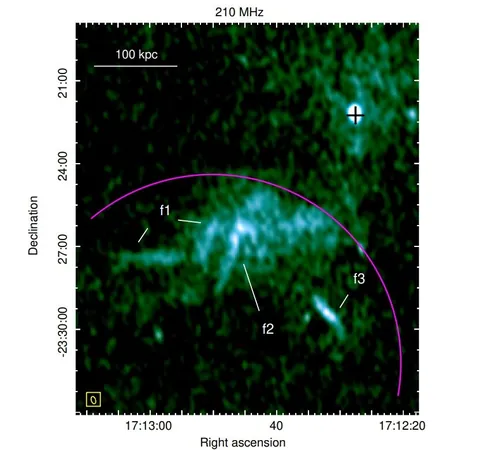
Astronomers Uncover Stunning Details in a Cosmic Radio Fossil of the Ophiuchus Cluster
2025-09-04
Author: Arjun
A Deep Dive into the Ophiuchus Galaxy Cluster
Astronomers using the cutting-edge Giant Metrewave Radio Telescope (uGMRT) have made thrilling discoveries about a colossal radio fossil lurking in the Ophiuchus galaxy cluster, located a staggering 390 million light years away. Their findings, unveiled in an August 26 publication in The Astrophysical Journal, provide a clearer picture of an enigmatic radio lobe believed to be remnants of cosmic activity.
What are Fossil Radio Lobes?
Fossil radio lobes are fascinating remnants formed from explosive bursts emitted by active galactic nuclei (AGN). These lobe structures are scattered at the fringes of galaxy clusters, often far removed from their parent galaxies. Despite their vast sizes, fossil lobes can be elusive, often appearing faint and diffuse, challenging astronomers to understand their full potential.
Exploring the Unknown
Driven by curiosity, a team led by Simona Giacintucci from the Naval Research Laboratory embarked on a mission to closely examine the fossil radio lobe within Ophiuchus. Utilizing the upgraded GMRT across two frequency bands—125–250 MHz and 300–500 MHz—they meticulously mapped the lobe's hidden structures.
Revealing Intricate Structures
The observations revealed stunning complexities within the fossil lobe, showcasing delicate, elongated radio filaments stretching an astonishing 16,000 to 33,000 light years. These intriguing structures, embedded in fainter emissions, hinted at a dynamic past.
The Mystery of Magnetic Fields
With a remarkably steep spectral index, the filaments suggest a turbulent history involving magnetic fields being stretched and intensified by magnetohydrodynamic forces. This phenomenon may accelerate the aging of relativistic electrons, leading to a steepening of their spectral emissions.
Estimating Cosmic Ages
Interestingly, the brightest region of the fossil lobe displayed a distinctive spectral break. From this, researchers estimated the radiative cooling age of the lobe, calculating it to be about 174 million years. This enduring visibility of the radio emissions raises intriguing questions about how such aged remnants continue to resonate across the vastness of space.
A Call for Further Exploration
This groundbreaking study not only sheds light on the Ophiuchus galaxy cluster but also opens the door for ongoing investigations into the mysteries of our universe. The findings underscore the need to explore how these ancient structures persist in the cosmic tapestry.

 Brasil (PT)
Brasil (PT)
 Canada (EN)
Canada (EN)
 Chile (ES)
Chile (ES)
 Česko (CS)
Česko (CS)
 대한민국 (KO)
대한민국 (KO)
 España (ES)
España (ES)
 France (FR)
France (FR)
 Hong Kong (EN)
Hong Kong (EN)
 Italia (IT)
Italia (IT)
 日本 (JA)
日本 (JA)
 Magyarország (HU)
Magyarország (HU)
 Norge (NO)
Norge (NO)
 Polska (PL)
Polska (PL)
 Schweiz (DE)
Schweiz (DE)
 Singapore (EN)
Singapore (EN)
 Sverige (SV)
Sverige (SV)
 Suomi (FI)
Suomi (FI)
 Türkiye (TR)
Türkiye (TR)
 الإمارات العربية المتحدة (AR)
الإمارات العربية المتحدة (AR)